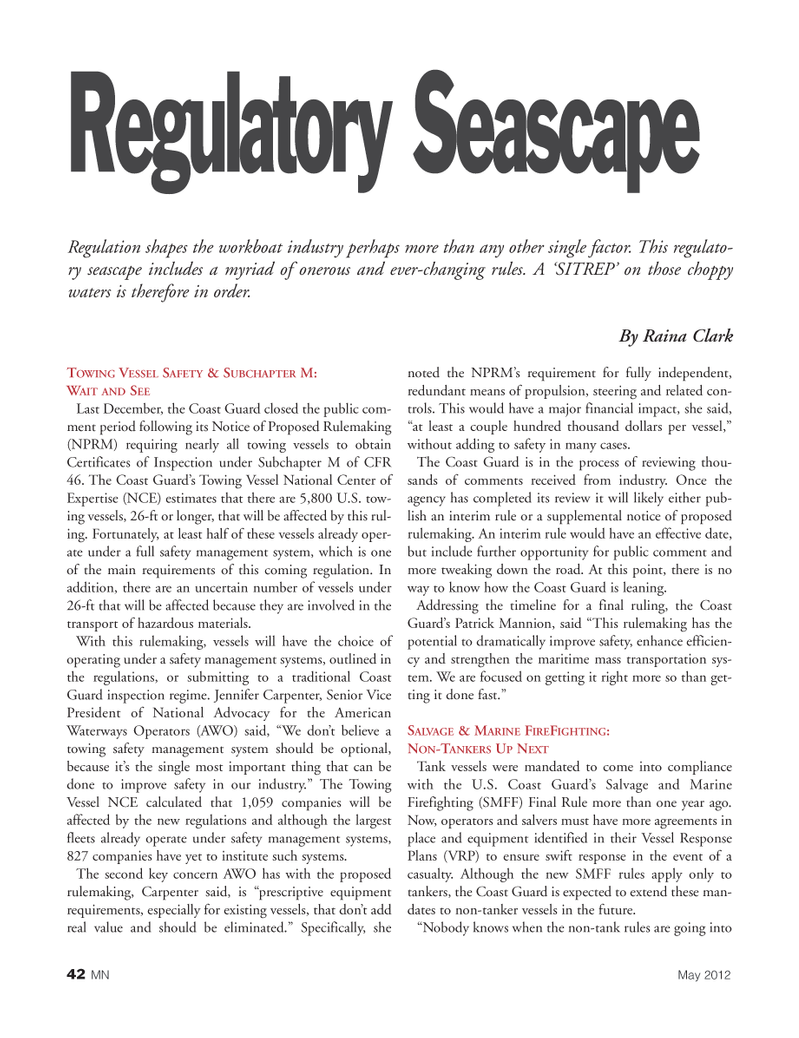
Page 42: of Marine News Magazine (May 2012)
Combat Craft Annual
Read this page in Pdf, Flash or Html5 edition of May 2012 Marine News Magazine
TOWING VESSELSAFETY & SUBCHAPTERM: WAITAND SEELast December, the Coast Guard closed the public com- ment period following its Notice of Proposed Rulemaking (NPRM) requiring nearly all towing vessels to obtain Certificates of Inspection under Subchapter M of CFR 46. The Coast Guard?s Towing Vessel National Center of Expertise (NCE) estimates that there are 5,800 U.S. tow- ing vessels, 26-ft or longer, that will be affected by this rul- ing. Fortunately, at least half of these vessels already oper- ate under a full safety management system, which is oneof the main requirements of this coming regulation. In addition, there are an uncertain number of vessels under 26-ft that will be affected because they are involved in the transport of hazardous materials. With this rulemaking, vessels will have the choice of operating under a safety management systems, outlined inthe regulations, or submitting to a traditional Coast Guard inspection regime. Jennifer Carpenter, Senior Vice President of National Advocacy for the American Waterways Operators (AWO) said, ?We don?t believe a towing safety management system should be optional, because it?s the single most important thing that can be done to improve safety in our industry.? The Towing Vessel NCE calculated that 1,059 companies will be affected by the new regulations and although the largest fleets already operate under safety management systems, 827 companies have yet to institute such systems. The second key concern AWO has with the proposed rulemaking, Carpenter said, is ?prescriptive equipment requirements, especially for existing vessels, that don?t add real value and should be eliminated.? Specifically, she noted the NPRM?s requirement for fully independent, redundant means of propulsion, steering and related con- trols. This would have a major financial impact, she said, ?at least a couple hundred thousand dollars per vessel,? without adding to safety in many cases.The Coast Guard is in the process of reviewing thou- sands of comments received from industry. Once the agency has completed its review it will likely either pub- lish an interim rule or a supplemental notice of proposed rulemaking. An interim rule would have an effective date, but include further opportunity for public comment and more tweaking down the road. At this point, there is no way to know how the Coast Guard is leaning. Addressing the timeline for a final ruling, the Coast Guard?s Patrick Mannion, said ?This rulemaking has the potential to dramatically improve safety, enhance efficien- cy and strengthen the maritime mass transportation sys- tem. We are focused on getting it right more so than get- ting it done fast.? SALVAGE & MARINEFIREFIGHTING: NON-TANKERSUPNEXT Tank vessels were mandated to come into compliance with the U.S. Coast Guard?s Salvage and Marine Firefighting (SMFF) Final Rule more than one year ago. Now, operators and salvers must have more agreements in place and equipment identified in their Vessel Response Plans (VRP) to ensure swift response in the event of a casualty. Although the new SMFF rules apply only to tankers, the Coast Guard is expected to extend these man- dates to non-tanker vessels in the future. ?Nobody knows when the non-tank rules are going into 42MNMay 2012Regulatory SeascapeRegulation shapes the workboat industry perhaps more than any other single factor. This regulato- ry seascape includes a myriad of onerous and ever-changing rules. A ?SITREP? on those choppy waters is therefore in order. By Raina Clark MN#5 (32-49):MN 2011 Layouts 5/7/2012 10:08 AM Page 42

 41
41

 43
43
